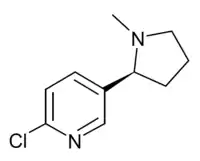6-Chloronicotine
6-Chloronicotine is a drug which acts as an agonist at neural nicotinic acetylcholine receptors. It substitutes for nicotine in animal studies with around twice the potency, and shows antinociceptive effects.[1][2][3][4]
 | |
| Identifiers | |
|---|---|
| |
| CAS Number | |
| PubChem CID | |
| ChemSpider | |
| CompTox Dashboard (EPA) | |
| Chemical and physical data | |
| Formula | C10H13ClN2 |
| Molar mass | 196.68 g·mol−1 |
| 3D model (JSmol) | |
| |
| |
See also
References
- Dukat M, Fiedler W, Dumas D, Damaj I, Martin BR, Rosecrans JA, James JR, Glennon RA (1996). "Pyrrolidine-modified and 6-substituted analogs of nicotine: A structure—affinity investigation". European Journal of Medicinal Chemistry. 31 (11): 875–888. doi:10.1016/S0223-5234(97)89850-9.
- Damaj MI, Fei-Yin M, Dukat M, Glassco W, Glennon RA, Martin BR (March 1998). "Antinociceptive responses to nicotinic acetylcholine receptor ligands after systemic and intrathecal administration in mice". The Journal of Pharmacology and Experimental Therapeutics. 284 (3): 1058–65. PMID 9495867.
- Dukat M, Dowd M, Damaj MI, Martin B, El-Zahabi MA, Glennon RA (1999). "Synthesis, receptor binding and QSAR studies on 6-substituted nicotine derivatives as cholinergic ligands". European Journal of Medicinal Chemistry. 34 (1): 31–40. doi:10.1016/S0223-5234(99)80038-5.
- Latli B, D'Amour K, Casida JE (June 1999). "Novel and potent 6-chloro-3-pyridinyl ligands for the alpha4beta2 neuronal nicotinic acetylcholine receptor". Journal of Medicinal Chemistry. 42 (12): 2227–34. doi:10.1021/jm980721x. PMID 10377228.
This article is issued from Wikipedia. The text is licensed under Creative Commons - Attribution - Sharealike. Additional terms may apply for the media files.